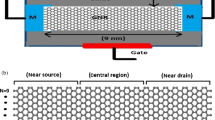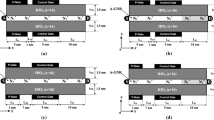Abstract
In this paper a novel graphene nanoribbon transistor with electrically induced junction for source and drain regions is proposed. An auxiliary junction is used to form electrically induced source and drain regions beside the main regions. Two parts of same metal are implemented at both sides of the main gate region. These metals which act as side gates are connected to each other to form auxiliary junction. A fixed voltage is applied on this junction during voltage variation on other junctions. Side metals have smaller workfunction than the middle one. Tight-binding Hamiltonian and nonequilibrium Green’s function formalism are used to perform atomic scale electronic transport simulation. Due to the difference in metals workfunction, additional gates create two steps in potential profile. These steps increase horizontal distance between conduction and valance bands at gate to drain/source junction and consequently lower band to band tunneling probability. Current ratio and subthreshold swing improved at different channel lengths. Furthermore, device reliability is improved where electric field at drain side of the channel is reduced. This means improvement in leakage current, hot electron effect behavior and breakdown voltage. Application to multi-input logic gates shows higher speed and smaller power delay product in comparison with conventional platform.











Similar content being viewed by others
References
Brennan, K.F.: Introduction to Semiconductor Devices for Computing and Telecommunications Applications. Cambridge University Press, Cambridge (2005)
Murali, R., Brenner, K., Yinxiao, Y., Beck, T.: Resistivity of graphene nanoribbon interconnects. IEEE Electron Device Lett. 30(6), 611–613 (2009)
Murali, R., Yang, Y., Brenner, K., Beck, T., Meind, J.D.: Breakdown current density of graphene nanoribbons. Appl. Phys. Lett. 94(24), 243114 (2009)
Murali, R.: Graphene transistors. Graphene Nanoelectronics from Materials to Circuits, pp. 51–91. Springer, New York (2012)
Gholipour, M., Masoumi, N., Chen, Y., Chen, D., Pourfath, M.: Asymmetric gate Schottky–Barrier graphene nanoribbon FETs for low-power design. IEEE Trans. Electron Devices. 61(12), 4000–4006 (2014)
Naderi, A.: Theoretical analysis of a novel dual gate metal-graphene nanoribbon field effect transistor. Mater. Sci. Semicond. Process. 31, 223–228 (2015)
Gholipour, M., Masoumi, N.: Graphene nanoribbon crossbar architecture for low power and dense circuit implementations. Microelectron. J. 45(11), 1533–1541 (2014)
Zhao, P., Guo, J.: Modeling edge effects in graphene nanoribbon field effect transistors with real and mode space methods. J. Appl. Phys. 105, 034503 (2009)
Jang, S.K., Jeon, J., Jeon, S.M., Song, Y.J., Lee, S.: Effects of dielectric material properties on graphene transistor performance. Solid-State Electron. 109, 8–11 (2015)
Naderi, A., Keshavarzi, P.: Electrically-activated source extension graphene nanoribbon field effect transistor: novel attributes and design considerations for suppressing short channel effects. Superlattices Microstruct. 72, 305–318 (2014)
Liang, G., Neophytou, N., Lundstrom, M., Nikonov, D.: Computational study of double-gate graphene nano-ribbon transistors. J. Comput. Electron. 7(3), 394–397 (2008)
Grassi, R., Gnudi, A., Gnani, E., Reggiani, S., Baccarani, G.: An investigation of performance limits of conventional and tunneling graphene-based transistors. J. Comput. Electron. 8(3), 441–450 (2009)
Kawaura, H., Sakamoto, T., Baba, T., Ochiai, Y., Fujita, J., Matsui, S., Sone, J.: Transistor operation of 30 nm gate-length EJ-MOSFETs. IEEE Electron Device Lett. 19(3), 74–76 (1998)
Kawaura, H., Sakamoto, T., Baba, T., Ochiai, Y., Fujita, J., Sone, J.: Transistor characteristics of 14-nm-gate-length EJ-MOSFETs. IEEE Trans. Electron Devices 47(4), 856–860 (2000)
Han, S., Chang, S., Lee, J., Shin, H.: 50 nm MOSFET with electrically induced source/drain (S/D) extensions. IEEE Trans. Electron Devices 48(9), 2058–2064 (2001)
Choi, Y.J., Choi, B.Y., Kim, K.R., Lee, J.D., Park, B.G.: A new 50-nm nMOSFET with side-gates for virtual source-drain extensions. IEEE Trans. Electron Devices 49(42), 1833–1835 (2002)
Arefinia, Z., Orouji, A.: Quantum simulation study of a new carbon nanotube field-effect transistor with electrically induced source/drain extension. IEEE Trans. Device Mater. Relat. 9(9), 237–243 (2009)
Sarvari, H., Ghayour, R., Dastjerdy, E.: Frequency analysis of graphene nanoribbon FET by non-equilibrium Green’s function in mode space. Physica E 43(8), 1509–1513 (2011)
Noei, M., Moradinasab, M., Fathipour, M.: A computational study of ballistic graphene nanoribbon field effect transistors. Physica E 44(7), 45–52 (2012)
Wang, Z., Li, Q., Zheng, H., Su, H., Shi, Q., Chen, J.: Tuning the electronic structure of graphene nanoribbons through chemical edge modification: a theoretical study. Phys. Rev. B 75, 113406 (2007)
Datta, S.: Electronic Transport in Mesoscopic Systems. Cambridge University Press, Cambridge (1995)
Datta, S.: Quantum Transport: Atom to Transistor. Cambridge University Press, Cambridge (2005)
Goharrizi, A.Y., Pourfath, M., Fathipour, M., Kosina, H., Selberherr, S.: An analytical model for line-edge roughness limited mobility of graphene nanoribbons. IEEE Trans. Electron Devices 58(11), 3725–3735 (2011)
Haixia, D., Kai-Tak, L., Samudra, G., Sai-Kong, Ch., Liang, G.: Graphene nanoribbon tunneling field-effect transistors with a semiconducting and a semimetallic heterojunction channel. IEEE Trans. Electron Devices 59(5), 1454–1461 (2012)
Pei, Zh, Feenstra, R.M., Gong, G., Jena, D.: SymFET: a proposed symmetric graphene tunneling field-effect transistor. IEEE Trans. Electron Devices 60(3), 951–957 (2013)
Hsu, F., Grinolds, H.: Structure-enhanced MOSFET degradation due to hot electron injection. IEEE Electron Device Lett. 5(3), 71–74 (1984)
Mao, L.F., Li, X.J., Wang, Z.O., Wang, J.Y.: The gate leakage current in graphene field-effect transistor. IEEE Electron Device Lett. 29(9), 1047–1049 (2008)
Ghadiry, M., Nadi, M., Saiedmanesh, M., Abadi, H.K.F.: An analytical approach to study breakdown mechanism in graphene nanoribbon field effect transistots. J. Comput. Theor. Nanosci. 11(2), 339–343 (2014)
Youngki, Y., Fiori, G., Seokmin, H., Iannaccone, G., Guo, J.: Performance comparison of graphene nanoribbon FETs with Schottky Contacts and doped reservoirs. IEEE Trans. Electron Devices 55(9), 2314–2323 (2008)
Naderi, A., Keshavarzi, P.: Novel carbon nanotube field effect transistor with graded double halo channel. Superlattices Microstruct. 51(5), 668–679 (2012)
Kopylov, S., Tzalenchuk, A., Kubatkin, S., Fal’ko, V.I.: Charge transfer between epitaxial graphene and silicon carbide. Appl. Phys. Lett. 97(11), 112109 (2010)
Farmer, D.B., Golizadeh-Mojarad, R., Perebeinos, V., Lin, Y.M., Tulevski, G.S., Tsang, J.C., Avouris, P.: Utilization of a buffered dielectric to achieve high field-effect carrier mobility in graphene transistors. Nano Lett. 9(12), 388 (2009)
Tseng, F., Unluer, D., Stan, M.R., Ghosh, A.W.: Graphene nanoribbons: from chemistry to circuits. In: Raza, H. (ed.) Graphene Nanoelectronics Metrology, Synthesis, Properties and Applications, pp. 555–586. Springer, Heidelberg (2012)
Author information
Authors and Affiliations
Corresponding author
Rights and permissions
About this article
Cite this article
Naderi, A. Double gate graphene nanoribbon field effect transistor with electrically induced junctions for source and drain regions. J Comput Electron 15, 347–357 (2016). https://doi.org/10.1007/s10825-015-0781-2
Published:
Issue Date:
DOI: https://doi.org/10.1007/s10825-015-0781-2




